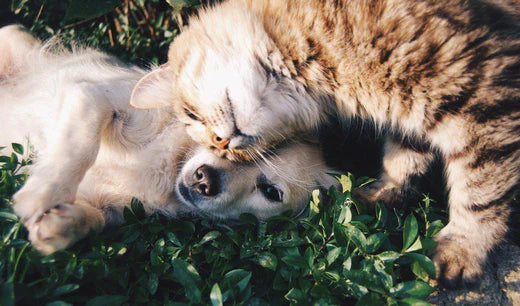Reprinted with permission from the author and in partnership with Porch.com.
So, you’re bringing your new puppy or kitten home. Congratulations on the beginning of many years of love, cuddles and laughs. There’s nothing better than a fuzzy pet to bring a smile to your face. Raising one is a big responsibility, but so worth the effort.
Before you bring home that bundle of energy and entertainment, you’ll want to pet-proof your home to keep him or her safe. Raising a puppy or kitten includes keeping eyes on him or her and removing safety hazards before mischief turns into a trip to the vet.
There are lots of things your pet may be curious about around your home, from foods and plants to electrical cords and chemicals. We’ll help you find them before your new pet does so you’re prepared and your new bundle of joy can grow up safe and happy.
Pet-Proofing Primer
Pet-proofing is similar to baby-proofing a home. Our advice is for both puppies and kittens (and bunnies and any other indoor pet that may roam loose). Remember when pet-proofing: cats can jump and climb much higher than dogs, so you’ll need to look both up and down when proofing your home for your new furry feline.
Pet lovers want to do the best for their new companions, and it’s simpler to put objects, like kids’ toys or hair bands, safely away than to coax a puppy or kitty to drop an offending object. Small objects can cause blockages in your pet’s stomach or intestines.
Get down on the floor and look at your house through your puppy’s eyes. What do you see? What looks tempting for a puppy to chew on? (Answer: Everything.) From electrical cords to table legs to toothpaste, everything is fair game for puppy or kittens. We’ll take you through some rooms and point out safety concerns to address.
Living or Family Room
You and your puppy or kitty will spend lots of time in the living room, so it’s one of the first rooms to tackle in pet-proofing your home. secure electrical cords, computer and phone charging cords, drapery cords, and any other cords at your new pet’s level. Puppies and kitties have sharp teeth and can bite into electrical cords. Secure tipsy furniture, too.
If you knit, sew or craft, make certain that all items like yarn, needles, thread, markers, glue sticks, and fabric scraps are out of reach. Put away buttons, batteries, magnets and other small objects. Remove knick-knacks, books, DVDs and any valuable item on your pet’s level that you don’t want munched on when your head is turned. The landscape of your living room may change while your pet is young, but it’s usually only temporary, and well worth it.
Laundry Room
Your laundry room harbors some concerns for your new family member. Detergents, bleach, stain removers, dryer sheets and even laundry are all tempting for your new pet. Puppies and kittens can also chew on dryer vent ductwork, on washing machine water lines, or electrical lines. They can also squeeze into small spaces in or behind the washer or dryer.
Bedrooms
Bedrooms are usually a safer environment than other rooms of the house, but there still are electrical cords to protect and clothes to remove from chair backs and floors. You may also consider a waterproof mattress pad for your bed in case puppy piddles. Keep in mind that young puppies have about as much control of their bladders as do diaper-wearing babies. So, take your puppy outside often so he or she knows that’s the place to do necessary business.
Take a look at your shoes and decide if you’d like to keep them wearable. If the answer’s yes, put them above your precious puppy’s reach, and resist the urge to give your puppy old shoes or socks to play with. You may know which loafers or pumps are off-limits, but to your teething puppy, they all smell like your feet and taste like heaven.
Make sure all small bedroom items, like watches, hair accessories, remotes, cell phone chargers, jewelry and personal items are safely in drawers. Puppies are even known to find retainers and dentures to be tasty (and expensive to replace) chew toys.
Bathroom
Your bathrooms harbor temptations for your new pal. Stray clothes like washcloths and socks are fair game for puppies and can cause blockages. Rubber bands, razors, dental floss, hair ribbons and rubber bands are irresistible for both kittens and puppies and are equally harmful.
Toothpaste contains xylitol, which is dangerous to pets. Always keep toothpaste, cleansers, makeup or applicators in a secure place like your medicine cabinet. Keep the toilet lid down to prevent water-bowl behavior and make sure toilet cleaners and drain-unclogging bottles are kept away from your pet.
Kitchen
Kitchens are full of tempting foods and potential dangers for your new pet. Making your kitchen pet-proof involves keeping irresistible but harmful foods out of their reach, including chocolate, grapes, raisins, avocados, macadamia nuts, onions, garlic, medicines, vitamins and coffee. Research all of the foods that are off limits to your cat or dog.
Sugar-free gums, which contain xylitol, are tasty but very dangerous for your pet. Keep these safely out of reach and remember (as your pet grows) that cats and medium to large-sized dogs can “counter-surf,” helping themselves to your just-made sandwich and more. Your pet can also swallow small objects like dropped bread twist-ties and rubber bands.
Few puppies or kittens can resist a garbage can, so try to keep those well out of reach of your pet. Some people keep trash cans in the cabinet under the sink, away from opportunistic pooches.
You may want to place a baby gate across your kitchen entrance to keep pets out of the kitchen when you can’t keep your full attention on them. They are masters at waiting underneath to catch any and all dropped food.
Other Pet Dangers in Your Home
As you move your way through the house, look for other potential dangers. For instance, keep handbags or kids’ backpacks out of reach of your puppy, kitten or adult pet. Sugar-free gums, candies, cough drops, over-the-counter medicines and prescriptions pose dangers to your pet, even in small doses. Keep children’s toys, plug-in air fresheners, candles, plastic snack bags and grocery bags away from your pet.
If your children have a tough time keeping their bedrooms neat, teach them to keep their bedrooms off-limits to growing puppies or kittens, either with a baby gate or a closed door. This can change later on as your pet matures.
Garages can be a danger zone for your pet as well, with chemicals like antifreeze, fertilizers and rat or mouse baits. Keep these high out of reach.
Protect your Best Furniture
To a puppy, your heirloom antique table looks like an oversized stick, and to your kitten, it’s just another nail-sharpening tree trunk. A puppy doesn’t understand why you think it’s great for him to retrieve sticks outside but don’t want him to chomp down on the “inside wood stick” table leg in your living room. If you have precious furniture, it might be a good idea to remove it from your new pet’s environment until he or she matures.
More Safety Tips for your Pet
Don’t forget to pet-proof your yard. Carefully consider what plants are in your home or yard. Some indoor plants, like Easter lily flowers and poinsettia, and outside plants like azaleas and sago palms are harmful to pets. Mulches that contain cocoa are also dangerous.
Many websites list pet-toxic plants so you can make sure you don’t have any already in your house or yard. Cats are curious and like to chew on plants throughout their lives, so take precautions with any plants within their reach.
A Crate is a Safety Tool
Using a crate for your puppy or kitten when you’re not home is a valuable safety tool. When you aren’t able to keep your eye on your pet, a crate keeps him or her from dangerous situations.
Introduce the crate with kindness, feeding your pet in the crate and placing toys in there for the puppy or kitty, but don’t leave toys in the crate while you’re gone, and never leave a collar on your puppy or kitten while in the crate. Try to keep your new pet’s stays in the crate short because he or she just came from the constant company of littermates, mom and humans, so being left alone for long periods can be stressful.
The Making of a Great Pet
Guiding your small, fuzzy puppy or kitten into a great companion takes patience, praise and persistence. Puppies and kittens don’t have the reasoning ability of humans and will instead act like – well, like adorable and sometimes frustrating puppies and kittens. No pet is perfect overnight, so be patient with the process. Your pet isn’t trying to misbehave – he or she is learning your language and your rules of the house, so be clear, consistent and kind. Reward any behavior you want your puppy to continue showing.
When training cats (yes, they’re trainable), also use positive reinforcement as well. Telling a cat to get off the table can seem like spitting into the wind, so entice it off with a treat or toy, or pick the cat up. Your prized heirloom vase may have to stay behind glass as long as you have a cat, but aren’t the cute meows, playful antics and contented lap naps worth it? Reward your kitten’s litter box deposits and for coming when you call. Kitty treats work wonders.
With good doses of patience and humor and a good session of house and yard pet-proofing, you and your new pet will quickly bond and enjoy many years of love and companionship. There’s nothing better than your purring cat snuggled up next to you or the jubilant, tail-wagging greeting from your dog as you walk in the door. Enjoy the excitement of puppyhood and kittenhood, knowing you’ve made their environment safe.
This article was originally posted on Porch.com.



